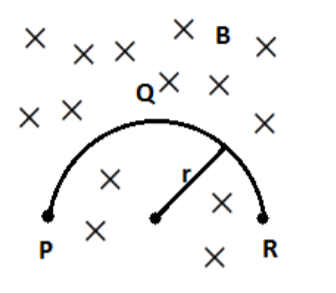
Answer
444.9k+ views
Hint: Here the circular coil is falling vertical to the magnetic field. We know that when a conductor moves in a magnetic field an emf will be induced. This principle is known as Faraday’s law of electromagnetic induction. This induced emf depends on the velocity and length of the conductor and the magnetic field. We can find out the potential difference using the equation for induced emf and the point at a higher potential.
Formula used:
\[e=l\left( v\times B \right)\]
\[v\times B=vB\sin \theta \]
Complete step-by-step solution:

From the figure, we can understand that the magnetic field is directed into the plane of paper. Whenever a current-carrying conductor moves in a magnetic field, an emf will be induced, which is given by, Induced emf, \[e=l\left( v\times B \right)\]
Where,
\[v\] is the velocity of the conductor
\[B\] is the magnetic field
\[l\] is the length of the conductor
As the conductor is falling vertically, the velocity of the conductor will be perpendicular to the magnetic field.
Then,
\[\left( v\times B \right)=vB\sin 90=vB\]
Then,
\[e=BVl\] ------ 1
Given that the radius semicircle is \[r\]. Then its diameter is \[2r\] which is equal to
the length \[l\].
\[l=2r\]
Then,
\[e=2rBV\]
Hence, magnetic force acting will be perpendicular to both \[\text{v and B}\].

Then, the direction of induced emf will be from R to P. We know that emf flows from higher potential to lower potential. Hence, R is at a higher potential.
Therefore, the potential difference developed across the ring is \[E=2rBV\] and R is at the higher potential. Hence the answer is option D.
Note: To determine the directions, right hand rule can be used. It shows that the magnetic field, force, and velocity of the conductor are perpendicular to each other. If we are using the equation \[e=BVl\], then \[B\], \[V\] and \[l\] are considered to be perpendicular to each other. If anyone of these, \[\vec{v}\parallel \vec{B}\], \[l\parallel \vec{B}\] and \[\vec{v}\parallel l\] conditions satisfy, then the induced emf in the circuit is zero.
Formula used:
\[e=l\left( v\times B \right)\]
\[v\times B=vB\sin \theta \]
Complete step-by-step solution:

From the figure, we can understand that the magnetic field is directed into the plane of paper. Whenever a current-carrying conductor moves in a magnetic field, an emf will be induced, which is given by, Induced emf, \[e=l\left( v\times B \right)\]
Where,
\[v\] is the velocity of the conductor
\[B\] is the magnetic field
\[l\] is the length of the conductor
As the conductor is falling vertically, the velocity of the conductor will be perpendicular to the magnetic field.
Then,
\[\left( v\times B \right)=vB\sin 90=vB\]
Then,
\[e=BVl\] ------ 1
Given that the radius semicircle is \[r\]. Then its diameter is \[2r\] which is equal to
the length \[l\].
\[l=2r\]
Then,
\[e=2rBV\]
Hence, magnetic force acting will be perpendicular to both \[\text{v and B}\].

Then, the direction of induced emf will be from R to P. We know that emf flows from higher potential to lower potential. Hence, R is at a higher potential.
Therefore, the potential difference developed across the ring is \[E=2rBV\] and R is at the higher potential. Hence the answer is option D.
Note: To determine the directions, right hand rule can be used. It shows that the magnetic field, force, and velocity of the conductor are perpendicular to each other. If we are using the equation \[e=BVl\], then \[B\], \[V\] and \[l\] are considered to be perpendicular to each other. If anyone of these, \[\vec{v}\parallel \vec{B}\], \[l\parallel \vec{B}\] and \[\vec{v}\parallel l\] conditions satisfy, then the induced emf in the circuit is zero.
Recently Updated Pages
Identify the feminine gender noun from the given sentence class 10 english CBSE

Your club organized a blood donation camp in your city class 10 english CBSE

Choose the correct meaning of the idiomphrase from class 10 english CBSE

Identify the neuter gender noun from the given sentence class 10 english CBSE

Choose the word which best expresses the meaning of class 10 english CBSE

Choose the word which is closest to the opposite in class 10 english CBSE

Trending doubts
Which are the Top 10 Largest Countries of the World?

Fill the blanks with the suitable prepositions 1 The class 9 english CBSE

How do you graph the function fx 4x class 9 maths CBSE

The Equation xxx + 2 is Satisfied when x is Equal to Class 10 Maths

What organs are located on the left side of your body class 11 biology CBSE

Difference between Prokaryotic cell and Eukaryotic class 11 biology CBSE

Give 10 examples for herbs , shrubs , climbers , creepers

Change the following sentences into negative and interrogative class 10 english CBSE

How much time does it take to bleed after eating p class 12 biology CBSE





